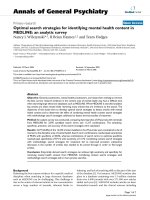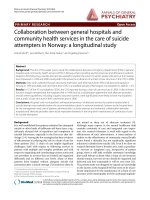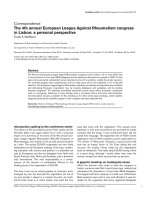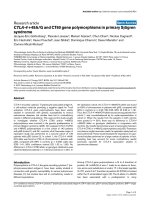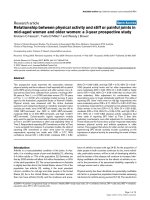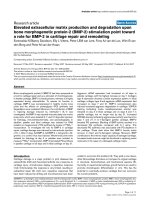Báo cáo y học: "Collaboration between general hospitals and community health services in the care of suicide attempters in Norway: a longitudinal study" ppt
Bạn đang xem bản rút gọn của tài liệu. Xem và tải ngay bản đầy đủ của tài liệu tại đây (574.91 KB, 8 trang )
Mork et al. Annals of General Psychiatry 2010, 9:26
/>Open Access
PRIMARY RESEARCH
© 2010 Mork et al; licensee BioMed Central Ltd. This is an Open Access article distributed under the terms of the Creative Commons
Attribution License ( which permits unrestricted use, distribution, and reproduction in
any medium, provided the original work is properly cited.
Primary research
Collaboration between general hospitals and
community health services in the care of suicide
attempters in Norway: a longitudinal study
Erlend Mork*
1
, Lars Mehlum
1
, Elin Anita Fadum
1
and Ingeborg Rossow
1,2
Abstract
Background: The aim of this paper was to study the collaboration between emergency departments (EDs) in general
hospitals and community health services (CHS) in Norway when providing psychosocial care and aftercare to patients
treated in EDs following a suicide attempt. We wanted to explore the extent to which quality indicators at the hospital
level measured in 1999 and 2006 could predict the presence or absence of a chain of care structure in the CHS in 2006.
Methods: Data were collected through structured interviews with informants from 95% of all general hospitals in
Norway in 1999 and 2006, and informants from CHS, in a stratified sample of Norwegian municipalities in 2006 (n = 47).
Results: In 15 of the 47 municipalities (32%), the CHS reported having a chain of care structure in 2006. A discriminant
function analysis revealed that the hospitals that in 1999 had: (a) a collaboration agreement with aftercare providers,
and (b) written guidelines, including a quality assurance system, were significantly more likely to have municipalities
with a chain of care structure in their catchment area in 2006.
Conclusions: Hospitals' and municipalities' self-reported provision of aftercare services for patients treated after a
suicide attempt was markedly below the recommendations given in national standards. Systems at the hospital level
for the management and care of patients admitted after a suicide attempt and systematic collaboration between
hospitals and aftercare providers seem to be important elements in the long-term maintenance of continuity of care
for suicide attempters.
Background
It is well established that patients admitted for attempted
suicide or other kinds of deliberate self-harm have a sig-
nificantly elevated risk of repetition and completion of
suicidal behaviours, especially in the first year after dis-
charge [1-4]. Among the few strategies that bear evidence
of effectiveness in reducing this risk is a chain of care for
these patients [5,6]. A chain of care implies significant
challenges, both with respect to delivering services to
patients with multiple and complex problems and with
respect to organising and coordinating various actors and
care providers in services that are funded and organised
differently and on different care levels. Many of these
patients leave hospital without adequate suicide risk
assessment after a suicide attempt [7,8] and they often do
not attend or drop out of aftercare treatment [9].
Although many experts in the mental healthcare field
consider continuity of care and integrated care impor-
tant, the research literature is weak with regard to the
effectiveness of such interventions. A meta-analysis of
studies on the effectiveness of community mental health
teams found a clinically, but not statistically, significant
reduction in deaths from suicide [10]. Even if we draw on
research literature from a broader area, such as psychiat-
ric services or integrated care, irrespective of patient
group, there is still little available systematic knowledge
that could inform us about what a chain of care structure
should contain, how the service should be organised and
delivered and how sustainable it will be over time [11].
The present study was designed to expand our knowledge
on the factors at the hospital level that seem to be of par-
ticular importance for the maintenance of a chain of care
structure at the municipality level by analysing longitudi-
* Correspondence:
1
National Centre for Suicide Research and Prevention, Institute of Clinical
Medicine, University of Oslo, Norway
Full list of author information is available at the end of the article
Mork et al. Annals of General Psychiatry 2010, 9:26
/>Page 2 of 8
nal data on chain of care structures for suicide attempters
in Norway.
In Norway, a main objective of the National Strategy for
Suicide Prevention (1994) was to improve the quality and
continuity of care for patients admitted to general hospi-
tals following a suicide attempt [12]. Supported by time
limited governmental funding, about 30% of Norwegian
general hospitals with an Emergency Department (ED)-
implemented chain of care programmes for suicide
attempt patients in the period from 1995 to 1999. Nearly
all of the health services in Norway are publicly funded
and these services are organised at 2 levels; hospital ser-
vices are organised at the regional level (comprising 4
health regions with 55 general hospitals), and primary
healthcare services (community health services) are pro-
vided at the municipality level (comprising 431 munici-
palities). This implies that a chain of care presupposes
collaboration between a hospital and each of the many
municipalities within the hospital's catchment area.
Based on experiences with the chain of care model and
international recommendations [13-16], national quality
standards for the clinical management of patients admit-
ted to general hospitals after a suicide attempt were
issued in 2001 by the Norwegian Board of Health [17].
General hospitals with an ED were required to satisfy
quality standards regarding suicide risk assessment,
training of staff, coordination of monitoring and manage-
ment of suicide attempting patients and procedures for
systematic collaboration with aftercare providers (see
Table 1 and [18] for details). The national standards do
not clearly define what constitutes a chain of care within
community health services (CHS) at the municipality
level, but recommend that CHS has a team or a coordina-
tor responsible for receiving referrals and interacting with
the local hospital in rapid (within 1 week from discharge)
and active aftercare. Follow-up usually consists of consul-
tations, aimed at crisis intervention, with the individual
and their family, pending other treatment to be estab-
lished, and guidance and support in establishing or main-
taining contact with other community based services (for
example, health and social services, school) and/or spe-
cialist mental health services.
In three previous studies [18-20] we have reported on
assessments of the quality of hospital services provided
for patients admitted after a suicide attempt. The results
indicate that maintaining high-quality clinical services to
suicide attempt patients seems dependent on clearly
defined standards and routines described in written
guidelines, a system to ensure that the guidelines are fol-
lowed and training of staff with respect to clinical man-
agement and care of patients. These and other previous
studies have been limited to the standards and services
given at EDs in general hospitals and we have no system-
atic knowledge about the aftercare services provided in
the CHS. In 2006, we therefore conducted an interview
study of the CHS in a sample of randomly selected
municipalities in Norway. The purposes of the present
paper are: (a) to assess how common it was for Norwe-
gian CHS to have a chain of care structure for suicide
attempters in 2006, (b) to explore the capacity of quality
indicators measured in 1999 and 2006 at the general hos-
pital EDs to predict the presence of a chain of care struc-
ture in the CHS in 2006, and (c) to explore whether
hospitals that had implemented a time-limited chain of
care programme between 1995 and 1999 were more likely
to have municipalities with a chain of care structure in
their catchment area in 2006.
Methods
CHS in municipalities in 2006
Participants and procedures
Data were collected through interviews with key persons
in municipalities in Norway in 2006. A randomly selected
sample of 50 municipalities and a substitution sample of
50 municipalities, stratified into 4 geographic/adminis-
trative regions and 3 levels of urbanisation, were drawn
from the population of all 431 Norwegian municipalities
by Statistics Norway (Oslo, Norway). Municipalities with
a population of fewer than 3,000 inhabitants, which
account for 6.1% of the Norwegian population, were
excluded. The selected municipalities were sent a written
invitation to participate in the study. The invitation was
specifically addressed to the employee within the CHS in
the municipality who was most involved in the care of
patients referred after a suicide attempt. The interviews
were conducted by telephone and lasted about 30 min. Of
the original 50 municipalities, 46 agreed to participate
(92%); thus, 4 additional municipalities were drawn from
the substitution sample. Two additional municipalities
were substituted, one due to intermunicipality coopera-
tion with another participating municipality and the
other because the informant became unavailable due to
illness. In total, six substitutions were made. Of the 50
municipalities, 47 (94%) were served by a general hospital
ED that had participated in both the 1999 and 2006 ED
survey [18,20] and the analyses reported in this paper are
based on information from these 47 municipalities, cov-
ering close to one-third of the entire Norwegian popula-
tion.
Measures
The interview addressed structural and organisational
aspects of the psychosocial follow-up of patients referred
to CHS in the municipality following a suicide attempt.
The structured interview protocol was based on the pro-
tocol developed for the 1999 ED survey, with changes
made for the purposes of the current study and after hav-
ing conducted pilot interviews. One member of the proj-
ect group (EAF) conducted all of the CHS interviews
Mork et al. Annals of General Psychiatry 2010, 9:26
/>Page 3 of 8
Table 1: Quality indicators in the treatment of patients admitted following a suicide attempt
Quality of care indicator 1999 2006 Stability (quality of care indicator present both in 1999
and 2006)
CCS in CHS in
2006 (n = 15),
n (%)
Not CCS in CHS in
2006 (n = 32), n (%)
Analysis CCS in CHS in
2006 (n = 15),
n (%)
Not CCS in
CHS in 2006
(n = 32), n (%)
Analysis CCS in CHS in
2006 (n = 15),
n (%)
Not CCS in CHS in
2006(n = 32), n (%)
Analysis
χ
2
(df) Pvalue χ
2
(df) Pvalue χ
2
(df) Pvalue
01: ED has a monitoring system 6 (40) 13(41) 0.00 (1) 0.97 11(73) 10 (31) 7.32 0.007* 6 (40) 6 (19) 2.43 0.119
02: ED has a team or a coordinator 13 (87) 16 (50) 5.81 (1) 0.02 13 (87) 15 (47) 6.71 0.010 13 (87) 9 (28) 14.06 0.000*
03: ED has written guidelines,
including a quality assurance system
9 (60) 6 (19) 8.00 (1) 0.005* 11 (74) 17(53) 1.73 0.188 7 (47) 4 (13) 6.65 0.010*
04: ED has provided training of staff 13 (87) 15 (47) 6.71 (1) 0.010* 13 (87) 16 (50) 5.81 0.016 12 (80) 6 (19) 16.21 0.000*
05: ED provides systematic
supervision of staff
6 (40) 3 (9) 6.19 (1) 0.013 8 (53%) 15 (47) 0.17 0.680 6 (40) 2 (6) 8.24 0.004*
06: ED has structured collaboration
with aftercare provider in CHS
13 (87) 12 (38) 9.92 (1) 0.002* 15 (100) 14 (44%) 13.68 0.000* 13 (87) 6 (19) 19.56 0.000*
07: ED staff routinely make suicide
risk assessment
15 (100) 32 (100) NS 13 (87) 31 (97) 1.78 0.182 13 (87) 31 (97) 1.78 0.182
08: ED has specific procedure for
patients who have not been
assessed for suicide risk
9 (60) 16 (50) 0.41 (1) 0.52 9 (60) 19 (59) 0.00 0.968 7 (47) 12 (38) 0.36 0.551
09: ED has specific guidelines for
follow-up care
11 (73) 22 (69) 0.10 (1) 0.75 15 (100) 23 (72) 5.22 0.022 11 (73) 17 (53) 1.73 0.188
10: ED refers at least 90% of patients
a
9 (60) 18 (56) 6 (40) 26 (84) 4 (29) 16 (53)
11: Patients receive information
about available help resources after
discharge
13 (87) 18 (56) 4.21 (1) 0.04 14 (93) 18 (57) 6.46 0.011 13 (87) 11 (34) 11.18 0.001*
12: ED establishes contact with
aftercare provider within first work
day after discharge
a
9 (60) 25
a
(78) (miss = 5) 15 (100) 30 (97) 0.50 0.482 9 (60) 24 (89) (miss = 5)
Data reported for Emergency Departments (EDs) in 1999, 2006 and in both 1999 and 2006 (stability) based on whether the community health services (CHS) did or did not have a chain of care structure (CCS) in 2006.
*Difference is significant based on an α level of P < 0.05 with Bonferroni correction for multiple testing (10 tests) and correction for the correlation between the quality of care indicators: 1999: P < 0.012, 2006: P < 0.009, Stability:
P < 0.011
a
These quality of care indicators had missing observations (range = 1-5) and were excluded from further analysis.
df = degrees of freedom; NS = not significant.
Mork et al. Annals of General Psychiatry 2010, 9:26
/>Page 4 of 8
between June and December 2006. The outcome measure
was whether or not the CHS in the municipality had a
chain of care structure (CCS) based on the following cri-
teria: (a) the CHS had a person or unit responsible for the
psychosocial follow-up of patients after hospital treat-
ment for a suicide attempt, (b) the CHS had structured
cooperation with the local hospital concerning the psy-
chosocial follow-up of patients hospitalised for a suicide
attempt, and (c) the CHS ensured that, at discharge, hos-
pitals provide the patient with information about after-
care providers in the CHS.
Data on the number of inhabitants in each municipality
and the degree of urbanisation of the municipality (rural,
rural/urban or urban) were gathered from Statistics Nor-
way. Information on the position of the informant in the
CHS (leader/non-leader) was gathered through the inter-
view.
EDs at Norwegian general hospitals in 1999 and 2006
Participants and procedures
Data were collected through interviews with key persons
in EDs in general hospitals in Norway in 1999 and 2006.
All Norwegian general hospitals with EDs were invited to
participate and at the interview we specifically targeted
the employee who was most involved in the care of
patients admitted following a suicide attempt. The
response rates were 95% at both time points (55 of 58
hospitals in 1999 and 52 of 55 hospitals in 2006). A total
of 31 of the hospitals provided services to the 47 partici-
pating municipalities described above. The interviews
were conducted by telephone and lasted about 30 min.
For details on the materials and methods of the hospital
study, see Mork et al.[20,21].
Measures
Interviews focused on 12 indicators of the quality level of
the psychosocial care delivered to patients admitted to
the EDs following a suicide attempt. These indicators
were designed to reflect essential aspects of routines for
the care and management of suicide attempters according
to recommendations and guidelines published in the
international literature [13-16,22-24]. Each of these 12
quality of care indicators, shown in Table 1, represents an
element of the treatment the ED either had or had not,
and were hence scored dichotomously. In a separate
paper, we have described the nationwide results [18]. In
the present study, only data on those EDs (n = 31) corre-
sponding to the CHS in the 47 municipalities are pre-
sented. Due to missing observations on quality of care
indicators 10 and 12 in both 1999 and 2006 (range = 1-5),
these variables were excluded from statistical analysis.
The remaining 10 quality of care indicators in the EDs in
1999 and 2006 were explored for their ability to predict
whether or not the CHS had a chain of care structure in
2006. Stability in the ED's quality of care was scored posi-
tively if the measured quality of care indicator was pres-
ent at the ED at both time points. We acquired
information on which hospitals implemented a chain of
care programme funded by the National Plan for Suicide
Prevention between 1995 and 1999 [12,25].
A rigorous definition of suicide attempt could not be
applied in these surveys. However, it is our experience
that in clinical practice in most inpatient EDs and CHS in
Norway, the term 'suicide attempt' generally refers to self-
harm behaviour with a varying degree of intention to die.
Nevertheless, since all participating ED's were inpatient
units, a fairly high medical lethality was generally present
in the patients who belonged to the population treated in
this context.
Statistical analysis
The main research question, to what extent the EDs qual-
ity of care indicators could predict whether or not the
CHS had a chain of care structure in 2006, was assessed
by x
2
tests in bivariate analyses, and discriminant func-
tion analysis (DFA). DFA is a linear stepwise regression
model to predict group membership from a set of predic-
tors. We were interested in assessing which of the quality
of care indicator variables in EDs at different times of
measurement could best discriminate between CHS with
or without a chain of care structure (Wilks' A). Multiple
logistic regression analysis models of whether or not CHS
had a chain of care structure were also estimated, to
check the robustness of results from DFA. The statistical
significance level in the bivariate analysis was set to P <
0.05 with Bonferroni correction for multiple tests (10)
and correction for correlation between predictor vari-
ables (see Table 1). All analyses were conducted using
SPSS v.14 (SPSS, Chicago, IL, USA).
Results
Chain of care structure in the CHS in 2006
Almost half of the CHS (47%) had a unit or person
responsible for coordinating the psychosocial follow-up
of suicide attempters after hospital discharge. Two-thirds
(68%) of the CHS had structured collaboration with their
local general hospital concerning the post-discharge psy-
chosocial follow-up of suicide attempters, and 43% had
regular meetings with the local hospital as a part of this
collaboration. A total of 53% of CHS ensured that, at dis-
charge, hospitals provided the patients with information
about the aftercare providers in the CHS.
In 15 (32%) of the municipalities, CHS reported that in
2006 they had a chain of care structure (CCS) that filled
the 3 criteria listed above. No significant differences were
found between CHS with and without a CCS with respect
to population size, degree of urbanisation or the position
of the informant (leader/non-leader).
Mork et al. Annals of General Psychiatry 2010, 9:26
/>Page 5 of 8
Table 2: The relationship between quality indicators at emergency departments (EDs) and the presence of chain of care structure (CCS) at community health services (CHS) in 2006
Predictor variables at EDs 1999 2006 Quality of care indicator present both in 1999 and 2006
(stability)
Standard
canonical
discriminan
t functions
CCS in CHS,
% (n)
correct
classified
Not CCS in
CHS, % (n)
correct
classified
Total, % (n)
correct
classified
Standardise
d canonical
discriminan
t functions
CCS in CHS,
% (n)
correct
classified
Not CCS in
CHS, % (n)
correct
classified
Total, % (n)
correct
classified
Standardise
d canonical
discriminan
t functions
CCS in CHS,
% (n)
correct
classified
Not CCS in
CHS, % (n)
correct
classified
Total, % (n)
correct
classified
Predictors entered: the 10
quality indicators (Table 1):
QI 6: ED has structured
collaboration with aftercare
providers
1.0 87 (13/15) 63 (20/32) 70 (33/47) 1.0 100 (15/15) 56 (18/32) 70 (33/47) 0.756
QI 2: ED has a team or a
coordinator
0.477 80 (12/15) 91 (29/32) 87 (41/47)
Predictors entered: the 10
quality indicators + chain of
care programme funded by
the national strategy
QI 6: ED has structured
collaboration with aftercare
providers in CHS
0.626 0.766 0.756
Chain of care programme
funded by the National
strategy
0.798 0.590 80 (12/15) 84 (27/32) 83 (39/47)
QI 1: ED has a monitoring
system
-0.587 73 (11/15) 81 (26/32) 79 (37/47)
QI 2: ED has a team or a
coordinator
0.477 80 (12/15) 91 (29/32) 87 (41/47)
Data from EDs reported for 1999, 2006 and for EDs where quality indicators were present in both 1999 and 2006 (stability). Discriminant function analysis.
Mork et al. Annals of General Psychiatry 2010, 9:26
/>Page 6 of 8
Predictors of a chain of care structure in the CHS
To examine whether quality of care indicators at EDs in
1999 could predict whether or not the CHS had a chain of
care structure in 2006, a series of analyses were con-
ducted with the presence of a CCS in the CHS in 2006 as
the dependent variable. First, all quality indicators pres-
ent in 1999, 2006 and at both times of measurement were
entered bivariately as presented in Table 1. Two quality
indicators from the hospital survey in 1999 were signifi-
cantly associated with the presence of a CCS in the CHS
in 2006: EDs that had established a structured collabora-
tion with aftercare providers and EDs with written guide-
lines, including a quality assurance system. Only two
characteristics of the EDs in 2006 were significantly asso-
ciated with the presence of a chain of care structure in the
CHS the same year: EDs that had established a structured
collaboration with aftercare providers and EDs that had a
monitoring system. However, when looking at stability at
the EDs over time (quality indicator present in both 1999
and 2006), six quality of care indicators were significantly
associated with CCS in the CHS (see Table 1).
To explore the degree to which characteristics of EDs at
different time points were able to correctly classify CHS
with and without a chain of care structure in 2006, a dis-
criminant function analysis was conducted, first with the
10 quality of care indicators as predictor variables (Table
2). A model that included EDs with structured collabora-
tion with aftercare providers and a team or coordinator
on both measurement points (giving stability over time)
provided the highest percentage (87%) of correctly classi-
fied CHS with and without a chain of care structure.
Including the variable 'chain of care programme during
the late 1990s' in the analysis increased the correct classi-
fication in 1999 (79%) and 2006 (83%) but did not change
the results on the stability measure. Similar results were
obtained by multiple logistic regression analyses (data not
shown).
Impact of having implemented a chain of care programme
in the 1990s
Of the 47 CHS, 22 (47%) were served by a local hospital
that had participated in a chain of care programme
funded by the National Plan for Suicide Prevention
between 1995 and 1999. CHS with CCS were significantly
more likely to belong to a hospital area that had partici-
pated in a chain of care programme in the 1990s than
CHS that had not (with CCS: 80%, without CCS: 31% (x
2
= 9.75, degrees of freedom (df) = 1, P = 0.002).
Discussion
Although all municipalities in Norway are supposed to
have a chain of care, only one-third of the CHS in this
representative sample of municipalities reported that
they in fact had such a structure. The observed discrep-
ancy between recommendations given in national guide-
lines and the reality described is much in line with
international research on general hospital services for
suicide attempters. Studies from other countries have
shown that a large proportion of self-harm patients
attending accident and emergency departments do not
receive a psychosocial assessment [7,26]. Furthermore,
substantial shortcomings have been found in staff train-
ing, interdisciplinary working and service planning, and
availability of all-hours specialist psychosocial assess-
ment [27-29].
Several explanations could apply to the observed dis-
crepancy between policy and reality; the number of sui-
cide attempts treated in general hospitals each year may
be low in small municipalities/rural areas and this may
negatively influence their ability to maintain services and
routines over time. On a more general level, factors such
as organisational changes, reforms, downsizing, change
of leadership or loss of key personnel may contribute to
the difficulty of establishing and maintaining collabora-
tion between different levels of service provision over
time. The lack of interventions that show evidence of
effectiveness in preventing suicide after a suicide attempt
[30] may also explain suboptimal collaboration between
ED's and CHS. However, several previous studies suggest
that shortcomings in hospital services provided to suicide
attempters are associated with an increased risk of
repeated suicidal behaviour [26,31,32]. Furthermore, an
ecological study by Cooper and colleagues [33] suggests
that the availability of mental health resources (mental
health treatment, crisis treatment, case management) in
the county of residence is associated with a reduction of
suicidal behaviour in the year following a suicide attempt.
Stability over time on quality indicators at the EDs was
the best predictor of whether or not community health-
care services had a chain of care structure in 2006, both
on the level of single quality indicators and in the multi-
variate analyses. This study highlights several factors that
could potentially contribute to a chain of care structure in
the CHS in the hospital's catchment area. Maintaining a
structured collaboration with aftercare providers and
having a team or a coordinator in the hospital over time
were both indicators associated with a relatively high pre-
diction of the presence or absence of a chain of care
structure in CHS in a representative sample of municipal-
ities. A significantly higher likelihood of having a chain of
care structure was also observed for CHS collaborating
with hospitals that had written guidelines with a quality
assurance system, training and systematic supervision of
staff and routinely gave patients information about avail-
able aftercare providers/services during discharge in both
1999 and 2006. One common denominator of these vari-
ables is that they require the hospital to allocate human
resources to the maintenance and implementation of
Mork et al. Annals of General Psychiatry 2010, 9:26
/>Page 7 of 8
local guidelines and practices both within the hospital
system and towards aftercare providers.
Having implemented a chain of care programme at gen-
eral hospitals in 1995 to 1999 significantly predicted the
presence of a CCS in CHS 7-10 years later. This finding is
in line with the results from another study conducted at
our centre: hospitals that had implemented a chain of
care programme in the latter half of the 1990s had stan-
dards and routines more in accordance with the recom-
mendations than hospitals without such programmes in
both 1999 and 2006 [18]. The chain of care programmes
were of limited duration and funding. Even though an
observational study such as the present work cannot
directly measure the effectiveness of a chain of care pro-
gramme, it is nevertheless noteworthy to observe that
this limited intervention was associated with higher stan-
dards of care at another level of service provision as much
as a decade later.
Strengths and limitations
The hospital study was conducted at two time points in a
nationwide fashion with remarkably high response rates.
The sample size in the CHS study was relatively small.
However, in light of the selection procedure and the fact
that the CHS in the municipalities actually covered one-
third of the entire Norwegian general population, we
believe our findings are reasonably generalisable to the
CHS in other parts of Norway and may have relevance to
CHS in many developed countries. Due to low statistical
power, there could be other variables that are important
but did not reach statistical significance. The results
reported in this paper have considerable overlap with the
findings from the longitudinal nationwide survey of hos-
pitals in Norway in 1999 and 2006 [18], which supports
the associations observed. The main limitations of this
study lay inherent within the study design and the limited
conclusions that can be drawn from an observational
study based on self-reported data gathered from different
levels of service provision. We do not know if the infor-
mants' accounts of the quality of care delivered to
patients correspond with the patients' points of view.
Nevertheless, we still believe this type of research may
provide valuable information to advise policy makers and
clinicians in their implementation and prioritisation of
different types of intervention and routines for manage-
ment and follow-up of suicide attempters.
This study has measured selected structural elements
in the CHS as indicators of the presence of a chain of care
for patients discharged from general hospitals following a
suicide attempt. There are a number of other ways the
chain of care model could be defined or operationalised.
Selecting structural elements as indicators of a chain of
care model is one way of managing the considerable het-
erogeneity in population size, population density and
organisation and content of the services delivered across
municipalities and service providers.
Is this what is needed to strengthen the continuity of
care for persons with suicide attempts? Currently, we do
not know what system of aftercare service provision may
best serve this mixed patient group. It could be that the
patients will be best served by anchoring the chain of care
in the general practitioner/family doctor. However, it is
not clear that all general practitioners will have the inter-
est or ability to provide active follow-up of these patients.
Conclusions
The provision of aftercare services for patients treated
after a suicide attempt at the community level is markedly
below the recommendations of the national standards in
Norway. It is likely that this has a negative effect on the
patients' prognosis. The results of this study suggest that
interventions aimed at establishing and maintaining
structured collaboration with aftercare providers and a
team or coordinator at the hospital level might be impor-
tant aspects in fostering the presence of a CCS in the
CHS. Regular training and supervision of staff in the
assessment and psychosocial care and aftercare of
patients admitted to EDs of general hospitals following a
suicide attempt, and establishing local guidelines with a
system for quality assurance, also seem to be important
factors in maintaining a chain of care model. More thor-
ough studies addressing programme content, structural
elements, theoretical underpinnings and the effects of
different chain of care programmes are needed to get a
further grasp of what works and for whom. This study
represents a first step giving a bird's eye view.
Implications for practice
In a national context, clinical standards and practices
should be monitored and evaluated against national rec-
ommendations at regular intervals. Because most of the
healthcare system in Norway and some other developed
countries are publicly funded, the health authorities can
and should take advantage of this fact in demanding
structured collaboration between the different levels of
service provision to strengthen the continuity of care.
Competing interests
The authors declare that they have no competing interests.
Authors' contributions
LM designed the study. EM, LM, EAF and IR wrote the protocol. EM drafted the
first manuscript and performed the statistical analysis. EM and EAF participated
in the acquisition of data. All authors participated in the interpretation of data,
revised it critically for important intellectual content and have read and
approved the final manuscript.
Acknowledgements
The study was supported by a grant from the Directorate of Health and Social
Affairs, Norway.
Mork et al. Annals of General Psychiatry 2010, 9:26
/>Page 8 of 8
Author Details
1
National Centre for Suicide Research and Prevention, Institute of Clinical
Medicine, University of Oslo, Norway and
2
Norwegian Institute for Alcohol and
Drug Research, Oslo, Norway
References
1. Angst F, Stassen HH, Clayton PJ, Angst J: Mortality of patients with mood
disorders: follow-up over 34-38 years. J Affect Disord 2002, 68:167-181.
2. Goldacre M, Seagroatt V, Hawton K: Suicide after discharge from
psychiatric inpatient care. Lancet 1993, 342:283-286.
3. Haw C, Bergen H, Casey D, Hawton K: Repetition of deliberate self-harm:
a study of the characteristics and subsequent deaths in patients
presenting to a general hospital according to extent of repetition.
Suicide Life Threat Behav 2007, 37:379-396.
4. Suominen K, Isometsa E, Suokas J, Haukka J, Achte K, Lonnqvist J:
Completed suicide after a suicide attempt: a 37-year follow-up study.
Am J Psychiatry 2004, 161:562-563.
5. Dieserud G, Loeb M, Ekeberg O: Suicidal behaviour in the municipality
of Baerum, Norway: a 12-year prospective study of parasuicide and
suicide. Suicide Life Threat Behav 2000, 30:61-73.
6. Mann JJ, Apter A, Bertolote J, Beautrais A, Currier D, Haas A, Hegerl U,
Lonnqvist J, Malone K, Marusic A, Mehlum L, Patton G, Phillips M, Rutz W,
Rihmer Z, Schmidtke A, Shaffer D, Silverman M, Takahashi Y, Varnik A,
Wasserman D, Yip P, Hendin H: Suicide prevention strategies: a
systematic review. JAMA 2005, 294:2064-74.
7. Bennewith O, Peters TJ, Hawton K, House A, Gunnel D: Factors associated
with the non-assessment of self-harm patients attending an Accident
and Emergency Department: results of a national study. J Affect Disord
2005, 89:91-97.
8. Bergen H, Hawton K: Variations in time of hospital presentation for
deliberate self-harm and their implications for clinical services. J Affect
Disord 2007, 98:227-237.
9. Runeson B, Wasserman D: Management of suicide attempters: what are
the routines and the costs. Acta Psychiatr Scand 1994, 90:222-228.
10. Malone D, Marriott S, Newton-Howes G, Simmonds S, Tyrer P: Community
mental health teams (CMHTs) for people with severe mental illnesses
and disordered personality. Cochrane Database Syst Rev 2007,
3:CD000270.
11. Smith SM, Allwright S, O'Dowd T: Effectiveness of shared care across the
interface between primary and specialty care in chronic disease
management. Cochrane Database Syst Rev 2007, 3:CD004910.
12. Norwegian Board of Health: Norwegian National Plan for Suicide
Prevention. Oslo Norway: Norwegian Board of Health; 1994.
13. National Research and Development Centre for Welfare and Health:
Suicide can be prevented: a target and action plan for suicide
prevention. Helsinki Finland: Painatuskekus OY; 1993.
14. Nationella rådet for självmordsprevention: Stød i självmordskriser:
nationellt program för utveckling av självmordsprevention [The
National Council for Suicide Prevention: Support in suicide crises:
national strategy for suicide prevention]. Stockholm Sweden: The
National Board of Health and Welfare; 1995.
15. Royal College of Psychiatrists: The general hospital management of
adult deliberate self-harm: a consensus statement on standards for
service provision. London UK: Royal College of Psychiatrists; 1994.
16. Sundhedsstyrelsen: Forslag til handlingsplan til forebyggelse af
selvmordsforsøg og selvmord i Danmark [The National Board of
Health: Proposal for National plan for prevention of suicide attempts
and suicide in Denmark]. Copenhagen Denmark: The National Board of
Health; 1998.
17. Norwegian Board of Health: Routines for monitoring, management and
follow-up care of patients hospitalised after suicide attempts [Rutiner
for registrering, behandling og oppf0lging av pasienter innlagt i
norske sykehus etter parasuicid]. Oslo, Norway: Norwegian Board of
Health; 2001.
18. Mehlum L, Mork E, Reinholdt NP, Fadum EA, Rossow I: Quality of
psychosocial care of suicide attempters at general hospitals in Norway
-a longitudinal nationwide study. Arch Suicide Res 2010, 14:146-57.
19. Mehlum L, Ystgaard M, Major E: After the suicide attempt: routines for
clinical evaluation and after-care of suicide attempters in Norwegian
general hospitals. Nordic J Psychiatry 1998, 52:98-99.
20. Mork E, Ekeid G, Ystgaard M, Holte A: Psychosocial follow-up after
parasuicide in Norwegian general hospitals. Tidsskr Nor Laegeforen
2001, 121:1038-1043.
21. Mork E, Ekeid G: Psykososial oppfølging etter parasuicid: rutiner og
praksis ved medisinske akuttavdelinger i Norge [Psychosocial follow-
up after parasuicide: routines and practice at Norwegian General
Hospitals]. In Thesis in psychology Oslo: University of Oslo; 2000.
22. Cotgrove A, Zirinsky L, Black D, Weston D: Secondary prevention of
attempted suicide in adolescence. Am J Adoles 1995, 18:569-577.
23. Evans MO, Morgan HG, Hayward A, Gunnell DJ: Crisis telephone
consultation for deliberate self-harm patients: effects on repetition. Br
J Psychiatry 1999, 175:23-27.
24. Morgan HG, Jones EM, Owen JH: Secondary prevention of non-fatal
deliberate self-harm. The green card study. Br J Psychiatry 1993,
163:111-112.
25. The Norwegian National Centre for Suicide Research and Prevention
[ />behandlingskjede_prosjekter.html]
26. Kapur N, House A, May C, Creed F: Service provision and outcome for
deliberate self-poisoning in adults results from a six centre descriptive
study. Soc Psychiatry Psychiatr Epidemiol 2003, 38:390-395.
27. Verwey B, van Waarde JA, van R I, Gerritsen G, Zitman FG: Availability,
content and quality of local guidelines for the assessment of suicide
attempters in university and general hospitals in the Netherlands. Gen
Hosp Psychiatry 2006, 28:336-342.
28. Bennewith O, Gunnell D, Peters T, Hawton K, House A: Variations in the
hospital management of self harm in adults in England: observational
study. BMJ 2004, 328:1108-1109.
29. Slinn R, King A, Evans J: A national survey of the hospital services for the
management of adult deliberate self-harm. Psychiatr Bull 2001,
25:53-55.
30. Crawford MJ, Thomas O, Khan N, Kulinskaya E: Psychosocial interventions
following self-harm: systematic review of their efficacy in preventing
suicide. Br J Psychiatry 2007, 190:11-17.
31. Hickey L, Hawton K, Fagg J, Weitzel H: Deliberate self-harm patients who
leave the accident and emergency department without a psychiatric
assessment: A neglected population at risk of suicide. J Psychosom Res
2001, 50:87-93.
32. Crawford MJ, Wessely S: Does initial management affect the rate of
repetition of deliberate self harm? Cohort study. BMJ 1998,
317:985-990.
33. Cooper SL, Lezotte D, Jacobellis J, Diguiseppi C: Does availability of
mental health resources prevent recurrent suicidal behavior? An
ecological analysis. Suicide Life Threat Behav 2006, 36:409-417.
doi: 10.1186/1744-859X-9-26
Cite this article as: Mork et al., Collaboration between general hospitals and
community health services in the care of suicide attempters in Norway: a
longitudinal study Annals of General Psychiatry 2010, 9:26
Received: 7 August 2009 Accepted: 11 June 2010
Published: 11 June 2010
This article is available from: 2010 Mork et al; licensee BioMed Central Ltd. This is an Open Access article distributed under the terms of the Creative Commons Attribution License ( ), which permits unrestricted use, distribution, and reproduction in any medium, provided the original work is properly cited.Annals of General Psychiatry 2010, 9:26

